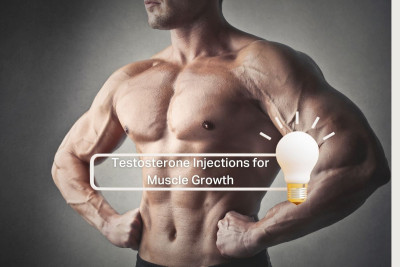Timeline Of Testosterone Replacement Therapy: What To Expect


Starting testosterone replacement therapy (TRT) can feel like a big step—especially if you're dealing with low energy, brain fog, or low libido. One of the most common questions men ask when beginning treatment is, "How long will it take before I feel a difference?"

The answer isn't the same for everyone, but understanding the general timeline of testosterone replacement therapy can help set realistic expectations and reduce frustration during the early weeks.
In Canada, more men are turning to TRT to reclaim their energy and vitality, but the changes it brings happen gradually—not overnight.
Whether you're starting TRT in Canada or just exploring your options, this article breaks down the typical week-by-week and month-by-month progress men experience.
While this guide is informed by clinical research, remember—every case is different, and it's essential to work closely with your doctor and pharmacist to track your response and adjust treatment if needed.
Topics covered in this article:
- Factors That Affect How Fast TRT Works
- TRT Timeline: Week-by-Week and Month-by-Month
- Key Areas of Change and When They Happen
- What If Results Are Slower Than Expected?
- The Role of Monitoring and Follow-Up in TRT
- Conclusion: Progress Takes Time, But It's Worth It
- Frequently Asked Questions (FAQs)
- References
Factors That Affect How Fast TRT Works
The timeline of testosterone replacement therapy (TRT) varies from person to person. While some men notice improvements within a few weeks, others may take several months to feel significant changes. This difference often comes down to a few key factors that influence how the body responds to treatment.

Here are the main elements that affect how quickly TRT works:
- Type and dosage of testosterone: Injections, gels, patches, and other delivery methods absorb and act at different rates. For example, injections often lead to more noticeable results in the early stages compared to gels, which release testosterone more gradually. The prescribed dose also affects the speed and strength of your response.
- Individual health factors: Your age, baseline testosterone levels, metabolism, body composition, and overall health all impact how your body processes and responds to hormone therapy. Younger men or those with moderately low levels may respond more quickly than older men or those with multiple health conditions.
- Consistency and follow-up care: Staying on schedule with your prescribed treatment, attending follow-up appointments, and getting blood tests to monitor your levels are critical to seeing steady progress. Inconsistent use or skipped doses can delay results.
Understanding these variables helps set realistic expectations for what TRT in Canada can do—and how soon you'll begin to notice changes. A tailored plan, guided by your doctor, ensures the safest and most effective outcome.
TRT Timeline: Week-by-Week and Month-by-Month
Testosterone replacement therapy doesn't deliver instant results—but the benefits do build steadily over time. Here's a general timeline of what many men experience when starting TRT in Canada, based on clinical research and patient reports. Keep in mind that individual responses can vary, and regular medical check-ins are key to tracking progress.
- Weeks 1–3: You may begin to notice subtle improvements in mood, motivation, and mental clarity. Some men also experience a slight boost in libido during this early phase.
- Weeks 4–6: Sexual interest typically stabilizes, and many report better energy levels and focus during the day. Sleep may also improve.
- Months 2–3: Changes in muscle strength and endurance become more noticeable, especially if you're active or lifting weights. Some reduction in fat mass, particularly around the midsection, may occur.
- Months 3–6: This is when most men experience more significant improvements in body composition, with increased lean mass, higher libido, and better stamina for both physical and sexual activity.
- Months 6–12: Bone density begins to improve, contributing to long-term strength and joint support. Emotional stability and overall well-being typically become more consistent, with many men feeling like themselves again.
- 1+ Year: At this point, you enter a maintenance phase, where the focus is on sustaining the benefits of TRT through ongoing care, healthy lifestyle habits, and consistent medical monitoring.
This timeline offers a helpful guide, but your body's response may be faster or slower. Patience, consistency, and a strong partnership with your doctor are key to long-term success.
Key Areas of Change and When They Happen
As testosterone replacement therapy (TRT) takes effect, improvements don't all happen at once. Different systems in the body respond at different rates, and knowing what changes to expect—and when—can help you track progress more clearly. Here's a breakdown of key areas of change and their general timelines, based on clinical research and real-world experience with TRT in Canada.
- Sexual Function: One of the most commonly anticipated benefits of TRT, changes in libido and erectile quality can begin within 3–6 weeks, with more noticeable improvements in sexual performance and interest by 3 to 6 months. Full stabilization may take longer in some men, depending on baseline hormone levels and overall health.
- Mood and Cognition: Improvements in mental clarity, focus, and emotional balance often show up early—typically in the first 3 to 6 weeks. Men frequently report feeling more motivated, less irritable, and more emotionally stable as testosterone levels normalize.
- Muscle Mass and Strength: Gains in lean muscle and physical strength tend to appear in the 2–3 month range, especially when paired with resistance training. These benefits often continue to increase through 6–12 months, contributing to better physical performance and stamina.
- Fat Distribution: TRT can support reduction in fat mass, particularly abdominal fat, with visible changes emerging around months 2–3. Fat loss typically stabilizes by 6–12 months, especially when paired with proper diet and exercise.
- Bone Density: Changes in bone mineral density happen more gradually. Improvements usually begin around 6 months, with continued increases over 1–3 years, supporting long-term strength and reducing fracture risk.
- Energy and Vitality: Boosts in daily energy, motivation, and overall vitality may begin in the first month, with more substantial improvements developing by months 2–3 and continuing as therapy is maintained consistently.
Everyone's response is slightly different, but knowing these general timeframes can help you stay consistent, optimistic, and engaged with your progress.

What If Results Are Slower Than Expected?
Not seeing the changes you expected from testosterone replacement therapy (TRT) right away can feel discouraging, but it doesn't always mean something is wrong. Some men experience slower progress due to a range of factors that can affect how the body absorbs and responds to treatment.
Here are some common reasons TRT results may be delayed:
- Inconsistent dosing or missed treatments: Skipping injections or forgetting to apply gels can lead to unstable hormone levels, making it harder to see consistent benefits.
- Absorption issues: Some men don't absorb topical treatments as effectively, which can limit testosterone uptake. In these cases, switching to another form, like injections, may yield better results.
- Wrong dosage: If your dosage is too low—or too high—your body may not reach an optimal hormone balance. This is why ongoing lab testing is critical.
- Underlying health issues or lifestyle factors: Conditions like sleep apnea, unmanaged stress, poor nutrition, or lack of exercise can blunt the effects of TRT, even if your hormone levels improve.
That's why follow-up blood work is so important. Your doctor will typically recheck your testosterone, estradiol, PSA, and other markers after the first few months of therapy. Based on the results and your symptoms, they can make dose adjustments or change your delivery method to help you get the best outcome.
If results are slower than expected, don't give up. TRT isn't a one-size-fits-all treatment—it's a process of fine-tuning and consistency, and working closely with your provider is the best way to get there.
The Role of Monitoring and Follow-Up in TRT
Successful testosterone replacement therapy (TRT) isn't just about starting treatment—it's about regular monitoring and ongoing communication with your healthcare provider to make sure the therapy is safe, effective, and tailored to your body's needs.
Once you begin TRT in Canada, your doctor will likely schedule follow-up blood work within the first 6–12 weeks, then periodically after that (typically every 3–6 months). These lab tests usually include:
- Total and free testosterone levels
- Estradiol (estrogen) levels, to monitor hormonal balance
- PSA (prostate-specific antigen), to assess prostate health
- Hematocrit and hemoglobin, to check for blood thickening
In addition to lab results, it's important to track your symptoms—both improvements and any new or lingering issues. Keep a record of your energy, mood, libido, strength, sleep, and overall well-being. This personal feedback is just as valuable as your bloodwork when it comes to fine-tuning your treatment.
If something feels off, or your results plateau, your provider may adjust your dosage or delivery method. Some men respond better to injections than gels or vice versa, and changes in lifestyle or body weight can also affect absorption and effectiveness over time.
Staying in close contact with your provider ensures that TRT continues to support your health goals—not just at the beginning, but in the long run.

Conclusion: Progress Takes Time, But It's Worth It
Testosterone replacement therapy isn't a quick fix, but with the right guidance and consistency, it can lead to powerful, lasting changes. From early shifts in mood and motivation to long-term improvements in strength, sexual health, and bone density, the timeline of testosterone replacement therapy reflects your body's gradual return to balance.
Whether you're weeks into treatment or just considering TRT in Canada, the key is to manage expectations, stay consistent, and partner with a healthcare provider who understands how to monitor and adjust your therapy over time. Results may not be instant—but they are real, measurable, and well worth the wait.
If you're not feeling the way you used to, don't wait for things to get worse. Start the conversation, get tested, and track your journey. With the right plan, you can move forward with clarity, energy, and confidence.
Frequently Asked Questions (FAQs)
Most men begin to notice improvements in mood, energy, or libido within 3–6 weeks, while changes in muscle mass, strength, and fat distribution typically appear over 2–6 months. Bone density improvements begin after 6 months and may continue for several years. While some benefits may be noticeable within 6–8 weeks, full results often take longer, especially for physical and structural changes.
Lack of results could be due to incorrect dosing, delivery method, or absorption issues. In some cases, underlying health conditions or inconsistent use may also affect progress. Talk to your doctor about follow-up bloodwork and possible adjustments.
Yes. Injections tend to deliver results faster than gels or patches, as they provide more consistent testosterone levels. However, the best method depends on your health profile, preferences, and how your body responds.
Absolutely. Regular exercise, strength training, good sleep, reduced stress, and proper nutrition all support and enhance the effects of TRT.
TRT is often a long-term therapy, especially for men with confirmed low testosterone. As long as it remains effective and safe under regular monitoring, many men stay on it for years with excellent outcomes.
References
UPGUYS has strict sourcing guidelines to ensure our content is accurate and current. We rely on peer-reviewed studies, academic research institutions, and medical associations. We strive to use primary sources and refrain from using tertiary references.- Onset of effects of testosterone treatment and time span until maximum effects are achieved, PubMed,
https://pmc.ncbi.nlm.nih.gov/articles/PMC3188848/#:~:text=Effects%20on%20sexual%20interest%20appear,at%20least%20for%203%20years. - Testosterone Replacement Therapy (TRT): What to Know, Medical News Today,
https://www.medicalnewstoday.com/articles/testosterone-replacement-therapy-trt#:~:text=and%20nasal%20discomfort.-,What%20to%20expect,initial%20treatment%20and%20then%20annually. - Testosterone therapy: Potential benefits and risks as you age, Mayo Clinic,
https://www.mayoclinic.org/healthy-lifestyle/sexual-health/in-depth/testosterone-therapy/art-20045728
This article is written for informational purposes only and does not constitute medical advice. The information provided in the articles cannot and should not replace advice from a healthcare professional. Talk to your healthcare provider about any physical or mental health concerns or the risks and benefits of any treatment or medication.





